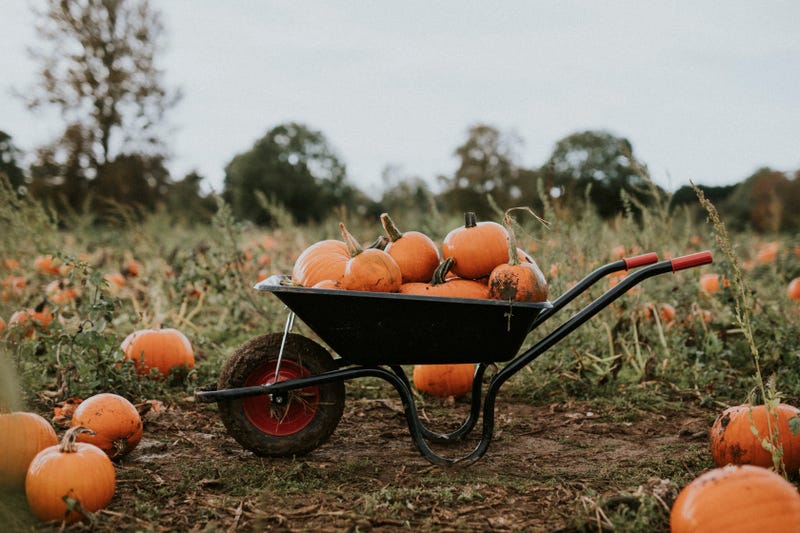
Blake Lanphier spent Monday afternoon unloading five semi-trucks with 28 bins of pumpkins — each bin weighed 800 pounds — for the start of pumpkin season at Historic Wagner Farm in Glenview.
Lanphier, who manages the 18-acre farm, said in recent years, they’ve struggled to keep up with customer demand. They have to source pumpkins from other local growers and arrange a weekly pickup.
“We have seen an increase in visitation over the last five years,” Lanphier said. In 2019, the farm saw about 100,000 annual visitors. Now, it’s reached 135,000 to 140,000 people.
It expects a strong turnout this year, with pumpkin sales starting Wednesday.
“Fall is our busiest time,” Lanphier said. “People want the experience of it. So we’re just trying to provide an experience to folks that want to come out to the farm.”
Since the pandemic, there’s been an increase in demand for fall activities with Chicagoans spending a carefree day picking pumpkins at places like Historic Wagner Farm to more elaborate pop-ups like Jack’s Pumpkin Pop-Up in West Town or JoJo’s Pumpkin Patch, adjacent to every JoJo’s Shake Bar location.
Social media is driving much of the growth. Fall-themed activities with Instagrammable moments have become a hallmark strategy for many Chicago area businesses. Places like JoJo’s Shake Bar and Historic Wagner Farm said these events help boost business and entice visitors to become year-round customers.
On TikTok, searching the category “Chicago fall” pulls up a number of videos counting down the best fall events. Influencers can be seen flocking to places like Jack’s Pumpkin Pop-Up, snapping selfies or making videos touting the festival’s corn maze, carnival games and axe throwing. The ticketed event bills itself as Chicago’s largest fall festival and runs until Nov. 2.
Historic Wagner Farm, which specializes in agricultural education, offers a “different experience” that is less “intense,” produce coordinator Karen Peditto said.
Owned by the Glenview Park District since 2000, the farm is free and open to the public. Its profits are reinvested into the farm which has horses, cows, chickens and pigs. There’s also a daily 4:30 p.m. milking demonstration.
“There’s some places that offer a ton of things,” Lanphier said. “For us, it doesn’t really make sense, and it doesn’t fit the mission of the farm. One of the things that we stress here is just being genuine in what we do — historic and produced here, or produced locally.”
But that doesn’t mean they don’t feel the urge to stay competitive.
A couple years ago, the farm hired a staffer whose job includes running its social media. The farm’s Instagram account has more than 4,000 followers.
“We’ve increased our social media stuff, not to the degree that it probably should be,” Lanphier said. “But there’s a lot more people I think we can reach.”
This year, it launched a new event, dubbed Autumn Roasts & Rides, that includes roasting marshmallows and a tractor-drawn wagon ride through the pasture for $12.
“I think part of the impetus for that is getting more people on the farm, obviously, but to engage in another kind of fall activity,” Peditto said. “Those fall activities are everywhere right now, and we do want to stay competitive.”
Keeping it fresh
Building a brand that won’t “get old” is a driving force for JoJo’s Shake Bar, a restaurant and bar with eight locations across Chicago, Detroit and Orlando, Florida.
JoJo’s Shake Bar has 127,000 Instagram followers and 17,500 TikTok followers. The company has its own social media and marketing team.
“I believe it’s much more difficult for [businesses] to compete and have longevity because of the importance of social media,” JoJo’s Shake Bar co-owner Robbie Schloss said. “You have to continue to remain important and creative and new, and the upkeep in that is very, very expensive. So we have utilized it to the extreme, and we make sure we are the best on every platform.”
Their River North restaurant, at 23 W, Hubbard St., has a large outdoor space than often hosts seasonal pop-ups.
On Sunday, the space became JoJo’s Pumpkin Patch with hay bales, pumpkins and a seasonal menu.
Schloss created the pop-up in 2020 when he realized its outdoor patio space would be perfect for socially-distanced dining. The “immersive dining experience” immediately went viral on social media, Schloss said. At the time, there weren’t many other businesses doing similar fall pop-ups, he said.
Seasonal menu items like the pumpkin-shaped grilled cheese and pumpkin patch shake — topped with a hearty slice of pumpkin pie, a taffy apple, toasted marshmallow and graham crackers — have become part of the draw.
“[The pumpkin patch] allows us to do over-the-top food, desserts, cocktails — the whole thing,” Schloss said. “Ours is handcrafted stuff that’s just well thought out. It’s as big a part of the experience as the ambiance. It’s definitely important for you to get photos and then eat it.”
Each location goes through more than 1,400 pumpkins during the six-week pop-up. Customers pay $35 for its pumpkin painting experience, which includes a pumpkin, paint, an entree and the pumpkin patch shake.
“A big part of why we do this is to give local families and families coming to the city a really fun place to do their pumpkin picking ... without having to drive an hour and a half, or two hours, to a farm,” he said.
JoJo’s Shake Bar now runs several pop-ups throughout the year. Winter Wonderland is the most popular, followed by Pumpkin Patch.
“Financially, it is beneficial to do [pop-ups],” Schloss said. “The main reason we do it is for the brand. We never want to get old. We never want to get boring. We always want to give our loyal following something fun to look forward to and reasons to come back, not just a few times a year but every season.”
